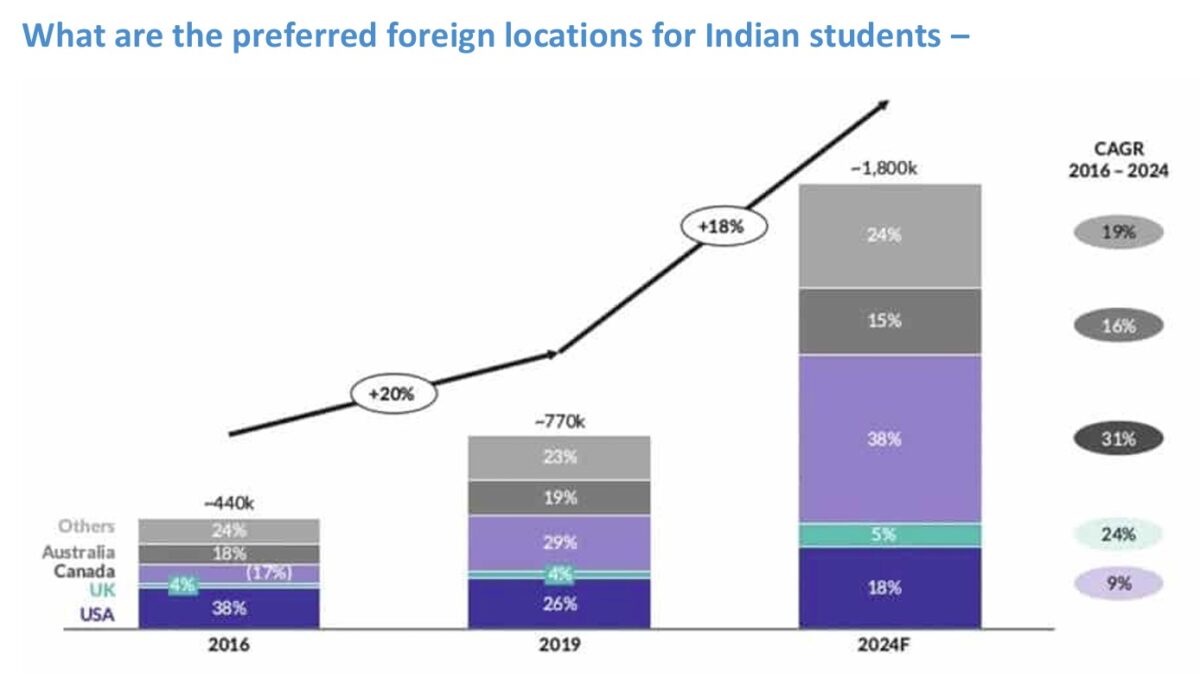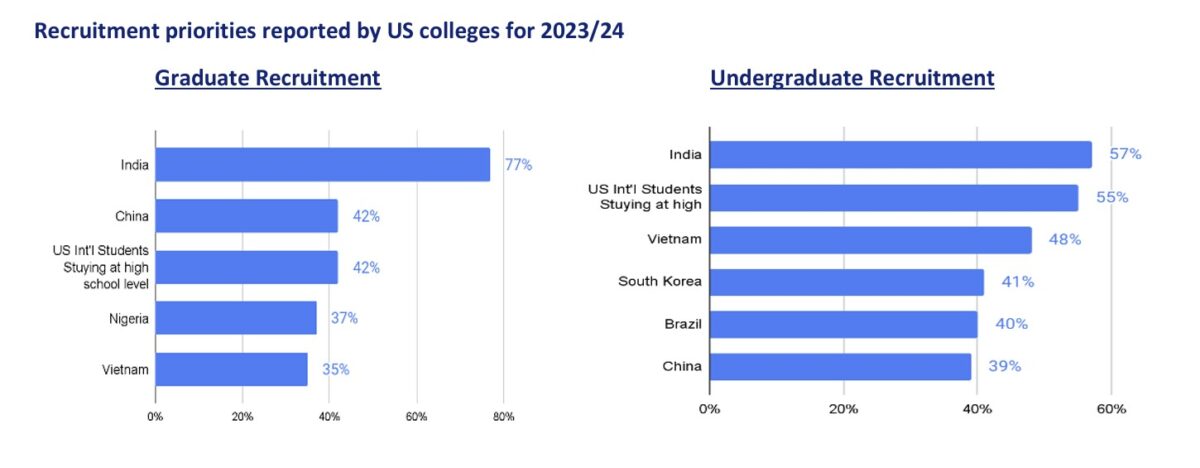Overseas Education Options for Indian Students

It’s important to note that over 1/6th of India’s population fall into the 15–24-year age bracket. Many of these students look at schools and colleges abroad for their higher education and this number has been steadily increasing. By the end of 2024, this number is projected at 1,800,000.


The United States of America: The US is home to many of the world’s top universities, including Harvard, MIT, and tanford. It offers a wide range of academic programs, a diverse and multicultural environment, and opportunities for research and innovation. There are approximately 253,631 Indian students holding active visas in the United States, a number close to that of Chinese students. The spring 2023 research conducted by the International Educational Exchange (IIE) indicates a growing focus of US institutions on India as a key recruitment destination. The United States government had implemented a national strategy, aiming to process over one million visas from India by 2023. In September of the previous year, the U.S. Mission to India proudly announced surpassing this goal by ~20%. This is a substantial increase in the preference for American higher education among Indian students.

Canada: Canada is known for its high-quality education system, welcoming immigration policies, and multicultural society. It is also a relatively affordable option compared to some other popular destinations. Canada is also home to an Indian population of nearly 2 million, constituting 80% of the South Asian community in the country and approximately 6% of Canada’s overall population. As the largest source of immigration into Canada, India contributed significantly, with an estimated 118,095 Indian immigrants in the year 2022. By the conclusion of December 2022, the number of Indians holding active study permits in Canada had risen by 47% compared to the previous year, reaching over 320,000. Notably, Indian students comprised almost 40% of the total international student population in Canada at that time.
Australia: Australia is another popular destination for Indian students, offering a high quality of life, a strong economy, and a multicultural society. It is also home to several top universities, such as the University of Melbourne and the University of Sydney. The number of Indian students in Australia increased by 34% between January – August 2023 compared to the same time frame for 2022. India makes up 17% of all foreign students in Australia. Graduates of Australian institutions are eligible to work in Australia for a period of up to 4 years, and 1,000 work and holiday visas are reserved for Indian students annually, according to India Economic Cooperation and Trade Agreement.
United Kingdom: The UK has a long history of education and is home to some of the world’s oldest and most prestigious universities, such as Oxford and Cambridge. It offers a wide range of academic programs and a well established international student community. There were 98,394 extensions of Graduate route extension approved till June 2023, of which 42% were granted to Indians.
As per UK news, for the academic year ending in June 2023:
- The UK issued approximately 500,000 study visas, with Indian students accounting for approximately 30% of the total.
- Nearly one-third of the study grants are sponsored to main applicants – the highest of any nationality.
- The total number of Indian student visas granted to the UK stood at almost 143,000, representing a 54% year on-year increase, placing India as the top sender of study visas to the UK.
Germany: The Germany has also emerged as a popular choice for Indian students seeking STEM (science, technology, engineering, and mathematics) degrees. It offers world-class universities with affordable tuition fees and the opportunity to work part-time while studying.
Popular programs of choice with Indian students studying abroad –
In the academic year 2022-23, the most popular fields of study for Indians were Business and Management, Engineering, Mathematics, and Computer Science.

Prospects for students pursuing higher education overseas (2024 & beyond)
India’s trajectory of student mobility in 2024 reflects a dynamic and responsive approach to changing geopolitical and visa processing landscapes. The trends observed in the Indian Education News 2023 indicate a notable shift in preferences, emphasizing a holistic learning experience. The anticipated spending of $70 billion per annum by Indian students on overseas education by 2025 underscores the substantial impact of these changes on choices, preferences, and the global economy.
- Agility and flexibility in response to geopolitical changes: In 2023, Indian students exhibited a remarkable level of agility and flexibility in response to geopolitical shifts. The diplomatic tensions between Canada and India have impacted student mobility. The unresolved standoff posed challenges for Indian students considering Canada as a destination for higher education. The ability to adapt quickly to changes in diplomatic relations and visa processing procedures reflects the resilience of the Indian education system and its stakeholders. Students are navigating evolving landscapes with a strategic and responsive mindset.
- Changing preferences and holistic Learning: Although traditional education hubs like the US, UK, Canada, and Australia continue to be popular, rising destinations like Germany, Singapore, Netherlands, and France are becoming increasingly prominent. Various factors, including reduced expenses, attractive employment prospects after graduation, and a wide range of academic programs, contribute to the changing preferences for study destinations. There is also a growing emphasis on a holistic learning experience. Beyond traditional academic considerations, students are seeking educational opportunities that provide a well-rounded development, including experiential learning, cultural exposure, and skill enhancement. This change reflects a broader understanding of education that goes beyond classroom learning.
- Projected Expenditure of $70 Billion by 2025: The estimation that Indian students will spend $70 billion annually on overseas education by 2025 underscores the economic impact of this shift. This substantial expenditure is not only a result of increased numbers but also indicative of a dynamic shift in the choices and preferences of Indian students. The economic contribution extends beyond tuition fees to include living expenses, travel, and other associated costs.
- Incorporation of Technology: The integration of cutting-edge technology such as artificial intelligence (AI) and machine learning has the potential to completely transform the study abroad experience. These technologies
will have a crucial impact on customizing education paths, assisting in language and cultural adjustment, facilitating well-informed course choices, and providing thorough career guidance. - Emphasize Proficiencies: Universities are placing greater emphasis on practical skills and industrial applicability in addition to academic qualifications. Internships, volunteer opportunities, and project-based learning will be essential elements of educational curricula, equipping students with the necessary skills to tackle real-world difficulties.
- Financial Accessibility Worries: Increasing tuition rates and rising living expenditures may provide difficulties for students. As a result, the significance of scholarships, financial aid alternatives, and work-study programs will increase, providing practical solutions to address concerns around affordability.
- Return on Investment: Students will prioritize programs that offer clear career options and have strong employability potential. STEM disciplines, business studies, and data analytics are expected to receive increased focus, in line with the changing needs of the labor market.



